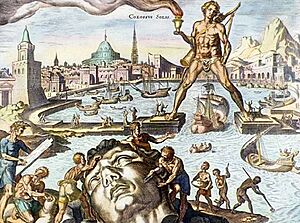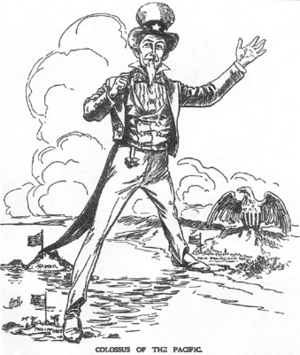The Rhodes Colossus facts for kids
Quick facts for kids The Rhodes Colossus |
|
|---|---|

Cecil Rhodes striding from Cape Town to Cairo
|
|
| Artist | Edward Linley Sambourne, Punch |
| Year | 1892 |
| Subject | Cecil Rhodes |

The Rhodes Colossus is a famous cartoon drawn by English artist Edward Linley Sambourne. It was published in Punch magazine in 1892. This cartoon shows what happened during the 'Scramble for Africa' time. This was when European countries, starting in 1884, quickly took over and divided up most of Africa. This period is also known as the New Imperialism era.
The image shows a powerful British businessman named Cecil Rhodes as a giant. He stands across Africa, holding a telegraph line. This shows his big dream to build a 'Cape to Cairo' railway and telegraph line. He wanted to connect most of the British colonies in Africa. The cartoon is a clever visual pun. It plays on the name of the Colossus of Rhodes, which was one of the Seven Wonders of the Ancient World.
Contents
How the Cartoon Was Made
The Rhodes Colossus was drawn by Edward Linley Sambourne. It first appeared in Punch magazine in 1892. The cartoon became very popular and was printed many times. Today, you can often see it in history books.
It was published in the 10 December 1892 issue of Punch. Along with the cartoon, there was a piece from The Times newspaper. This piece talked about Rhodes' plan to build an electrical telegraph line. He wanted it to go all the way from Cape Town in South Africa to Cairo in Egypt.
The newspaper article said that Mr. Rhodes planned to extend the telegraph line north. It would cross the Zambesi river, go through Nyassaland, and along Lake Tanganyika to Uganda. The article also mentioned his huge goal to complete the overland telegraph line from Cape Town to Cairo. This would connect England to all its colonies and areas of influence in Africa.
After the cartoon and newspaper piece, there was a funny poem by Edwin J. Milliken. This poem made fun of Rhodes and his big plans. Punch magazine often included satirical poems or stories with its cartoons. The poem called Rhodes a "Director and Statesman in one" and a "Seven-League-Booted Colossus." It described him as striding "O'er Africa... to forward black emancipation." It also called him a "shrewd trader" and a "diplomat full of finesse."
The idea of Rhodes as a "Colossus" was a well-known joke. It started in South Africa. Punch magazine and others had used this joke before.
What the Cartoon Shows
Sambourne drew this cartoon as a visual pun. He showed Cecil Rhodes like the famous ancient Greek statue, the Colossus of Rhodes. The cartoon followed the common idea of the Colossus. This idea showed the statue standing with its legs wide apart over Rhodes harbour.
In the cartoon, Rhodes uses the telegraph line to measure the distance. His right foot is in Cape Town, South Africa. His left foot is in Cairo, Egypt. This shows his big "Cape to Cairo" plan for more colonial expansion in Africa. In his right hand, Rhodes holds a pith helmet. A rifle hangs over his right shoulder.
Rhodes stands in a strong, open pose. Experts say this shows his great power and influence. This was during the time when European countries were taking over Africa. His giant size in the cartoon shows his huge goals and his wish for even more power on the continent.
How the Cartoon Became Famous

This cartoon quickly became very popular. It was often used in history books. It helped to show what the Scramble for Africa and the whole New Imperialism era were like. When the cartoon is shown today, people often don't mention its original meaning. That meaning was about a planned telegraph line. Instead, they use it to represent the "Cape to Cairo" idea in a broader way.
In his book King Leopold’s Ghost, author Adam Hochschild introduces Rhodes. He calls him a "future South African politician and diamond magnate." Rhodes once famously said he "would annex the planets" if he could.
The South African cartoonist Jonathan Shapiro made a cartoon in 2009 that copied Sambourne's work. In Shapiro's cartoon, Chinese premier Wen Jiabao stands in Rhodes' place. He holds Nkosazana Dlamini-Zuma, who was then the Minister of International Relations and Cooperation, like a marionette. The Dalai Lama watches from Asia. This cartoon made fun of the relationship between China and Africa. It especially highlighted recent events between China and South Africa. This was after the Dalai Lama was not allowed a visa to attend a peace conference in Johannesburg. Many believed China had put pressure on South Africa to deny the visa.
In 2013, political cartoonist Martin Rowson also used Sambourne's cartoon as inspiration. He published a satirical drawing in The Guardian newspaper on February 1. This drawing commented on British Prime Minister David Cameron's policies regarding Algeria and the French intervention in Mali.
What Rhodes' Actions Meant
This cartoon has become one of the most used images. It helps people understand the time of New Imperialism and the European takeover of Africa.
A scholar named Patrick Bond has described Rhodes' impact in modern-day South Africa. He called it "one of the world's most lucrative, and destructive." This refers to the many unfair and misleading agreements Rhodes made. He signed these with different African peoples. These agreements gave him parts of their land.
See also
- Rhodes Must Fall

